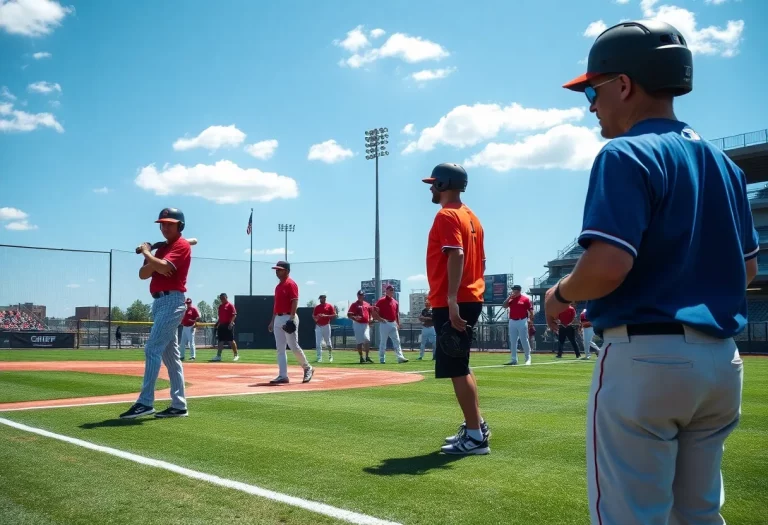News Summary
In the wake of a significant injury to a high school player, Nebraska’s baseball community is grappling with the prospect of introducing a safety base. Tanner Klein’s knee injury during a game has reignited discussions about player safety, echoing similar debates at the collegiate level. While some coaches support the safety base for reducing injuries, others resist change citing tradition and financial implications. As opinions diverge, there is urgency for players’ well-being, potentially leading to pivotal changes in high school baseball in Nebraska.
Nebraska High Schools Face Growing Debate on Safety Base after Injuries
In Nebraska, the fervor surrounding high school baseball is spotlighted after a significant injury rattled the community. Tanner Klein, a senior lead-off hitter for the Norris baseball team, suffered a painful knee injury during a collision at first base. This unfortunate incident occurred on April 8 during a game against Lincoln Southeast, triggering both sympathy and concern among players, coaches, and parents alike. Initially, there were fears that Klein’s injury could end his season, but thankfully, he only sustained a bone bruise and has been gradually making his way back to the diamond.
Reigniting Safety Concerns
The collision has sparked renewed conversations about the potential introduction of a double first base, commonly referred to as a safety base. This innovative concept aims to reduce collisions between runners and fielders by providing an additional base for runners to utilize. The topic has garnered significant attention among national high school baseball organizations, all keen to explore potential rule changes that could enhance player safety.
Interestingly, Major League Baseball (MLB) has entertained the idea of a safety base but has yet to implement it at the professional level. In contrast, college baseball has taken the lead with this initiative. The Southeastern Conference took a bold step by introducing the double first base during its conference tournament in 2024, aimed specifically at improving player safety. Following the success of this trial, all NCAA Division I, II, and III programs will be required to adopt the double first base by 2025. The Big Ten Conference, which includes the University of Nebraska-Lincoln, has swiftly aligned with this decision, mandating the double first base in its conference games.
Current Stance in Nebraska High Schools
Unlike their collegiate counterparts, Nebraska’s high schools have yet to make the leap toward this safety innovation. The Nebraska School Activities Association (NSAA) has made it clear that discussions about the safety base are still in the early stages. A recent survey conducted by the NSAA revealed that only 41% of 43 responding coaches are in favor of adopting the safety base. This lack of overwhelming support means that a majority vote to move forward is still far off.
However, a recent poll among local coaches conducted by a trusted source painted a different picture. In this poll, 15 out of 18 coaches expressed their support for transitioning to the safety base. This divergence in opinions brings forth the need to dissect the core reasons behind the varying stances.
Arguments for and Against the Safety Base
Supporters of adopting the safety base strongly argue that it emphasizes player safety and actively works to prevent unnecessary injuries that could sideline athletes for extended periods. The hope is that by prioritizing safety, games can be played more vigorously without the looming threat of injury causing significant consequences.
On the flip side, some coaches argue against the change. Their concerns revolve around the longstanding traditions of the game, the financial implications that might accompany such a shift, and skepticism regarding the necessity and practicality of introducing a second base. These opposing views fuel the ongoing debate, creating a rift between maintaining tradition and evolving to ensure player welfare.
Changing Perspectives
As discussions unfold at the state level, change may be slow in coming. Yet personal incidents like Klein’s injury could inspire coaches and decision-makers to reconsider their stances on the safety base more urgently. The Norris baseball coach, for example, has had a change of heart on the issue after witnessing the aftermath of the incident. His shift underscores how crucial it is for those involved in the sport to prioritize player safety in the face of potential injuries.
As the conversation continues, there is no doubt that the age-old game of baseball in Nebraska stands at a crucial crossroads between athlete safety and tradition. With evolving rules and an increasing awareness of player welfare, the possibility for positive change may just be on the horizon. Only time will tell if the safety base will become a standard feature in the dream of young athletes playing baseball in Nebraska.
Deeper Dive: News & Info About This Topic
LIVE BALL Resources
Alabama High School Baseball Quarterfinals Heating Up
Oklahoma City High School Soccer Match Set for Showdown
Highlights from Summerville’s Young Athletes
Tragic Accident During Graduation Game in Arlington
Avonworth Tops 3A Rankings as Playoffs Approach
Isabelle Murdock Joins Central Wyoming College Cross Country Team
Monroe Central High School Wins State Championship!
Reno Hosts 5A/3A Regional Swim Meet at Moana Springs
Henry Dixon Dominates Michigan High School Track Rankings
Shamokin Stars Achieve All-State Basketball Honors
Additional Resources
- Lincoln Journal Star
- Wikipedia: Baseball Rules
- The Crimson White
- Google Search: College Baseball Safety Base
- Sports Illustrated
- Google Scholar: Safety Base in Baseball
- 247 Sports
- Encyclopedia Britannica: Baseball Safety Measures
- Outkick
- Google News: Baseball Safety Rules


